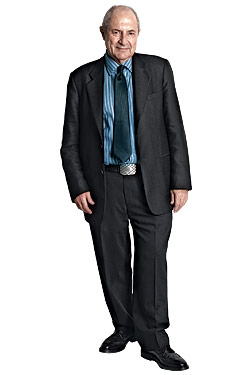
Dakis Joannou does not seem to be at risk of imminent default. The Greek billionaire owns hotels and a construction business and has been a major international distributor of Coca-Cola, including in Russia, and he is one of the biggest collectors of contemporary art in the world. He has a giant house in Athens and three different vacation homes on three different islands, so he also has the standard Greek billionaire’s 114-foot yacht in order to move comfortably among them. The boat is named Guilty, and two years ago it was painted black and yellow and purple and blue by Jeff Koons in the style of World War I ships whose camouflage was “designed to confuse.” (Joannou’s last yacht, Protect Me From What I Want, took its name from Jenny Holzer.)
Koons also made a wedding cake for Joannou’s daughter in 2005. It was shaped like a heart and covered with enormous toppers made of blue and purple marzipan in the shape of children’s party balloons. “We still have them,” Joannou says. “We didn’t eat them. But I suppose we could.” Joannou smiles. He looks like a television version of a kindly gramps, the sort of man who might be cast in commercials hawking oatmeal and Aleve, rather than a guy who once paid $305,000 for a Christopher Wool painting that reads, “If you can’t take a joke, you can get the fuck out of my house.”
This week, Joannou’s house is his apartment on the 48th floor of the Trump Tower on Fifth Avenue. (A publicist accidentally directed me to Olympic Tower, a few blocks south, where the doorman tried to be helpful: “Maybe you mean Niarchos?”) He’s in town for the opening of a show featuring works from his massive collection (1,500 pieces at last guess) as curated by Koons at the New Museum. The minute that news of the exhibit broke, the art world went into high-dudgeon mode over its ethics. “[The New Museum] is supposed to be an independent arbiter of taste and art-historical value,” NYU professor Noah Kupferman told the New York Times in November. “It is not supposed to surrender itself to a trustee and donor whose collection stands to be enhanced in value by a major museum show.” But the show’s many defenders were quick to point out that Joannou is more of a modern-day Medici, albeit a Medici with a taste for bright colors and a sense of humor that tends toward the ironic. What’s more, they say, he rarely resells things from his collection.
Joannou himself is totally unfazed. “It’s a non-issue,” he says. “I was just very happy to be on the front page of the New York Times.” (Nor does he seem panicked by the economic “mess” back home in Greece. Europe, he thinks, will step up to the plate.)

As a patron, Joannou has gone to great extremes for his artists, even looking into whether part of the George Washington Bridge could be shut down so as to truck a Koons work out to the airport. “I have one luxury in my life: I do whatever I feel like doing,” he has said regarding his collection. Or, as curator Dan Cameron told W magazine a few years back, Joannou “has an ability that few museums have. When he finds something that interests him, he can decide on the spot and buy, regardless of price.”
A year and a half ago, Joannou decided that his New York apartment was kind of blah, so he called his friend and adviser Jeffrey Deitch (the gallerist soon to head the Los Angeles Museum of Contemporary Art), who commissioned six artists to “graffiti” all the non-windowed walls—or, rather, graffiti slender removable panels that could be placed over the walls. Ara Peterson covered a wall in a version of television static. Clare Rojas, whose panel is over the sofa, did a painting of two naked men, one visibly aroused, on two horses. On the floor is a wildly colored “quilt” by Jim Drain, which is made of stuffed stockings woven together and decorated with photos of Joannou’s four children and his wife of 30 years, Lietta.
In Athens, he’s always moving stuff around the house. If necessary, he’ll move walls and ceilings and windows to accommodate the art. “Every week,” he says, “I call Maurizio [Cattelan], I call Jeffrey [Deitch], and I say, ‘What do you think about these two pieces together?’ ” Only Koons’s One Ball Total Equilibrium Tank, which is the first piece Joannou ever bought (for $2,700; it was 1985), Marcel Duchamp’s Fountain, and a Koons statue of Michael Jackson and his pet chimp stay permanently in place. “Michael Jackson,” says Joannou, “is very, very fragile.”
Have good intel? Send tips to intel@nymag.com.